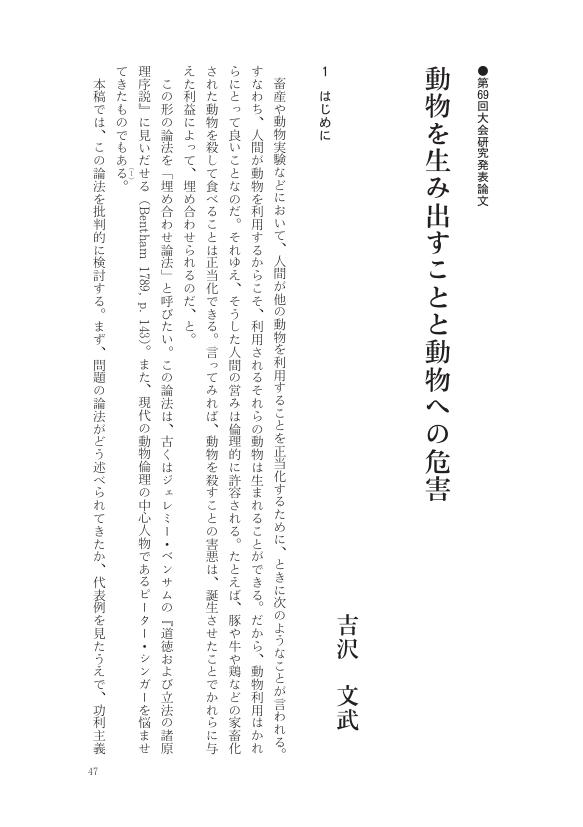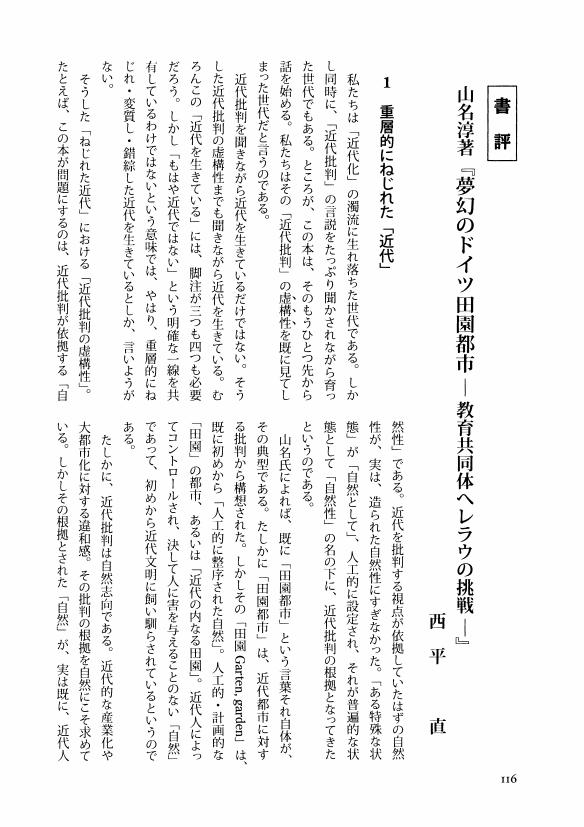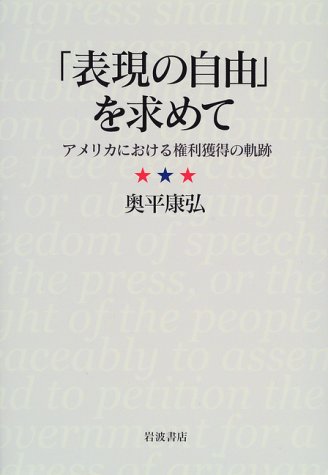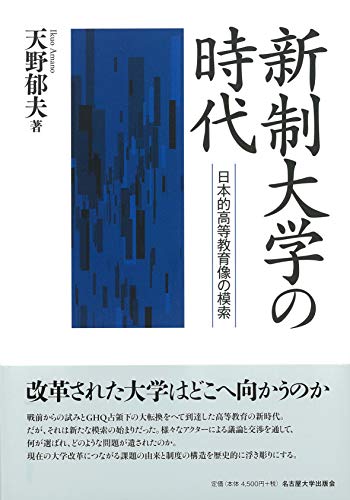2 0 0 0 OA 磯野富士子先生を偲んで
- 著者
- 芝山 豊
- 出版者
- モンゴル研究会
- 雑誌
- モンゴル研究 (ISSN:03852210)
- 巻号頁・発行日
- no.25, pp.43-45, 2008-12-31
2 0 0 0 OA 動物を生み出すことと動物への危害
- 著者
- 吉沢 文武
- 出版者
- 東北哲学会
- 雑誌
- 東北哲学会年報 (ISSN:09139354)
- 巻号頁・発行日
- vol.36, pp.47-61, 2020 (Released:2020-06-23)
- 著者
- 田子 多津子
- 出版者
- 東北哲学会
- 雑誌
- 東北哲学会年報 (ISSN:09139354)
- 巻号頁・発行日
- vol.20, pp.75-76, 2004-05-31 (Released:2018-02-28)
2 0 0 0 OA 新撰万葉集の成立 (下)
- 著者
- 熊谷 直春
- 出版者
- 早稲田大学国文学会
- 雑誌
- 国文学研究 (ISSN:03898636)
- 巻号頁・発行日
- vol.61, pp.12-22, 1977-03-25
2 0 0 0 OA カントのエゴイズム論 : 『実用的見地における人間学』の冒頭をめぐって
- 著者
- 宮島 光志
- 出版者
- 東北哲学会
- 雑誌
- 東北哲学会年報 (ISSN:09139354)
- 巻号頁・発行日
- vol.5, pp.17-30, 1989-05-31 (Released:2018-02-28)
2 0 0 0 OA 内包論理の限界とその新たな構成可能性について
- 著者
- 高橋 要
- 出版者
- 東北哲学会
- 雑誌
- 東北哲学会年報 (ISSN:09139354)
- 巻号頁・発行日
- vol.4, pp.14-30, 1988-04-30 (Released:2018-02-28)
2 0 0 0 OA 現象学と科学哲学
- 著者
- 本間 謙二
- 出版者
- 東北哲学会
- 雑誌
- 東北哲学会年報 (ISSN:09139354)
- 巻号頁・発行日
- vol.3, pp.1-16, 1987-04-28 (Released:2018-02-28)
2 0 0 0 OA 場所的論理と浄土教
- 著者
- 長谷 正當
- 出版者
- 西田哲学会
- 雑誌
- 西田哲学会年報 (ISSN:21881995)
- 巻号頁・発行日
- vol.4, pp.1-21, 2007 (Released:2020-03-24)
2 0 0 0 OA ワイマール期ドイツにおける「子どもの描画」問題 美的人間形成論の新たな可能性を求めて
2 0 0 0 OA 山名淳著『夢幻のドイツ田園都市-教育共同体ヘレラウの挑戦-』
- 著者
- 西平 直
- 出版者
- 教育哲学会
- 雑誌
- 教育哲学研究 (ISSN:03873153)
- 巻号頁・発行日
- vol.2007, no.95, pp.116-123, 2007-05-10 (Released:2009-09-04)
2 0 0 0 OA 超臨界二酸化炭素による洗浄技術
- 著者
- 斎藤 功夫
- 出版者
- The Vacuum Society of Japan
- 雑誌
- 真空 (ISSN:05598516)
- 巻号頁・発行日
- vol.43, no.6, pp.654-659, 2000-06-20 (Released:2009-10-20)
- 参考文献数
- 21
2 0 0 0 「表現の自由」を求めて : アメリカにおける権利獲得の軌跡
2 0 0 0 新制大学の時代 : 日本的高等教育像の模索
2 0 0 0 性暴力被害を聴く : 「慰安婦」から現代の性搾取へ
- 著者
- 金富子 小野沢あかね編
- 出版者
- 岩波書店
- 巻号頁・発行日
- 2020
2 0 0 0 古記録記事を通してみたる禁色勅許--平安後期殿上人層を中心として
- 著者
- 小川 彰
- 出版者
- 国史学会
- 雑誌
- 国史学 (ISSN:03869156)
- 巻号頁・発行日
- no.127, pp.p41-64, 1985-10
2 0 0 0 OA 透明な言語・不透明な知性 コメニウス『光の道』における光のメタファー
- 著者
- 北詰 裕子
- 出版者
- 教育哲学会
- 雑誌
- 教育哲学研究 (ISSN:03873153)
- 巻号頁・発行日
- vol.2007, no.96, pp.22-41, 2007-11-10 (Released:2009-09-04)
- 参考文献数
- 68
This paper examined J. A. Comenius' The Way of Light as a theory of language in the metaphor of light, one that is crucially related of cognition of things.In The Way of Light, Comenius expresses the world and human beings in a metaphor of light. External light illuminates all things and clarifies every thing. It overcomes every darkness in the world. On the other hand, Internal light means intellectual light in particular. This light overcomes darkness of ignorance in soul, and intellect has an opaque characteristic. Opaque intellect receives light, blocks its further penetration, keeps the truth of things within itself, and reflects and scatters it around the world again. It can be said that working of this intellect is a function of the language. From the point of view of human history, Comenius said that the scatter of light spreads through cognition, conversation, a meeting of a church, books, printing and the art of navigation. Furthermore, this process is expansion of education to give light for human mind.Comenius considers the cognition of things from the perspective of light because he has an assumption that every visible thing in the world has truth of God. And ideal universal language is designed as a medium to represent the truth of things.In other words, what is considered as the language in Comenius has triplex meanings : a language that articulates the light as opaque intellect, a language as the world itself has, and a transparent language that represents the world. These triplex meanings of language are deeply related to the educational thought of Comenius.
- 著者
- 平田 仁胤
- 出版者
- 教育哲学会
- 雑誌
- 教育哲学研究 (ISSN:03873153)
- 巻号頁・発行日
- vol.2007, no.95, pp.71-88, 2007-05-10 (Released:2010-05-07)
- 参考文献数
- 20
In recent years, “representation learning, ” which assumes that knowledge presupposes representation, has been criticized. In this criticism “Wittgenstein'sparadox” has been used to point out the logical impossibility of “representation learning” : as long as the notion of “representation” is assumed, the paradox would happen inevitably and spoil “representation learning.” However, the paradox HERE is considered to be merely a theoretical fiction for it does not happens in normal cases, and hence, does not spoil learning. In view of the criticism, this paper attempts to show, by analyzing elaborately Wittgenstein's rule-following considerations, that “Wittgenstein's paradox” can not be seen simply as a fiction. In Wittgenstein's rulefollowing considerations, the notion of “inner-binding” and that of “outer-binding” are crutial. The former is a disposition that is built through “training”. This disposition enables one to judge the “sameness” and to be convinced of the necessity of that sameness. The latter is “institution” that is established through the repetition of “peaceful accordance”. The two bindings sometimes do not conflict with each other.This is exactly the case in which rule-following operates.“Inner-binding” has not been formed yet in an earlier stage of “rule” learning.Therefore “outer-binding” conflicting with the inner does not appear. But the two can come to differentiate themselves from each other as learning progresses and as the inner has been formed. The conflict between the inner> and the outer is equivalent to the case which “Wittgenstein's paradox” describes. Accordingly the possibility of differentiation exists latently and the paradox is not a theoretical fiction.The latent possibility of “Wittgenstein's paradox” indicates that learners are not in a position to distinguish the two. This suggests that learning is uncertain and learning theories are not transparent to learners.
2 0 0 0 OA 希望、この無気味なるもの O・F・ボルノウ「希望の哲学」再考
- 著者
- 井谷 信彦
- 出版者
- 教育哲学会
- 雑誌
- 教育哲学研究 (ISSN:03873153)
- 巻号頁・発行日
- vol.2006, no.94, pp.1-20, 2006-11-10 (Released:2009-09-04)
- 参考文献数
- 36
本稿は、現代ドイツの教育学者ボルノウと、彼の思想に深い影響を与えた哲学者ハイデガーについて、両者の思索の関わりを問い直す研究の一環として位置づけられるものである。ハイデガー哲学からの影響を認めながらもボルノウは、その思想の根幹である「存在への問い」が開き示す可能性については、それを繰り返し排除あるいは無視し続けてきた。しかしながら、この拒絶がそもそも或る種の誤解に基づくものであったとすればどうだろうか。むしろその点に、ボルノウ自身によっては主題的に論じられることのなかった別なる思索の可能性が潜在しているのではないか。ハイデガーによる「存在への問い」についての考察を通じて、ボルノウによる人間学的な教育学がもついっそう豊かな可能性を解き放つことが、本研究に与えられた最終的な課題である。特にその端緒として本稿では、ボルノウによる「希望の哲学」をハイデガーによる「不安の分析論」をふまえて問い直すことが試みられる。
2 0 0 0 OA 森田伸子著『文字の経験-読むことと書くことの思想史-』
- 著者
- 丸山 恭司
- 出版者
- 教育哲学会
- 雑誌
- 教育哲学研究 (ISSN:03873153)
- 巻号頁・発行日
- vol.2006, no.93, pp.151-157, 2006-05-10 (Released:2009-09-04)
いまこの文章を読んでくださっている皆さんであれば、すでに文字をめぐるさまざまな経験をお持ちだろう。書店あるいは図書館の膨大な文献を前にして目のくらむような思いをされたことはなかっただろうか。あるいは、慣れない横文字と格闘しながら「読み」にともなう摩擦を実感されたこと、買ったばかりのペンで何度も自分の名前や恋い焦がれるひとの名前を白い紙に書き連ねてみた経験。もちろん、文字のない文化に生まれ育ってもひとはまっとうに生きていけよう。一方、文字を持ってしまったわれわれには、もはや文字は-意識しようがしていまいが-われわれの身体と感情と思考と願望を方向付ける枠組みの一つとなっている。文字はわれわれの生活を制限付けるとともに豊かにもしてくれているのだ。本書は、文字に生きたひとびとに著者自身が寄り添いながらそうした生活の豊かな広がりを描き出した作品である。森田氏は本書について次のように言う。「本書は、ここ数年来私の研究関心を占めてきた、言語、とりわけ文字言語が人間にとって持つ意味について考察をまとめたものです」 (二七五頁) 。本編には、既発表論文四篇が全体構成にあわせて裁断され書き直されて組み込まれているものの、「全体としてはほぼ書き下ろしといっていいもの」である。四篇の論文のうちには古くは一九八七年に発表されたものもあり、森田氏がこのテーマに長く関心を寄せられていたことがうかがえる。それどころか、「文字の人」であったご両親への想いが綴られているように (二七七頁以降) 、氏の研究関心はパーソナルな強い思いに裏打ちされている。氏が「本書は研究書として書かれたというよりは、私の自由な考察を述べたものになりました」 (二七六頁) と言うのも、本書が専門家に留まらず広い読者に向けて書かれたからだけでなく、文字に生きたひとびとへの共感があるからであろう。また、本書のねらいについて森田氏は次のように言う。「本書では、文字をめぐるさまざまな思索と経験について書かれたテクストを取り上げ、できる限りその思索と経験を忠実に追体験してみることに努めてみたい」 (iV頁) 。そして、読者は森田氏に誘われてさまざまな物語を追体験することになる。フランシス・コッポラ監督の映画『アウトサイダー』に描かれたジョニーとダラスの死に立ち会い、パリの裏町を舞台にした映画から、親になかば捨てられたユダヤ人少年モモとトルコ移民の老人イブラヒムとの交流を見守る。二人の「文盲」、一八世紀フランスの羊飼いデュヴァルと二〇世紀イタリアの羊飼いガヴィーノの自伝。ドラッグとセックスの日常を生きる若者を描いた小説『レス・ザン・ゼロ』の主人公クレイの救い。フィクションであれ、ノンフィクションであれ、固有名を持つ個人の多様な生が文字をめぐる人生として確認されるのである。こうした人生の追体験を縦糸にして、さまざまなリテラシー観、啓示・啓蒙・聾教育・国民形成における文字思想の検討を横糸として本書は編まれている。
2 0 0 0 OA 「新優生学」と教育の類縁性と背反 「他者への欲望」という視座
- 著者
- 森岡 次郎
- 出版者
- 教育哲学会
- 雑誌
- 教育哲学研究 (ISSN:03873153)
- 巻号頁・発行日
- vol.2006, no.93, pp.102-121, 2006-05-10 (Released:2010-01-22)
- 参考文献数
- 74
The purpose of this paper is to examine new eugenics and education.For the last several years, such ideas as “Designers Baby” and “Perfect Baby” have been discussed in terms of “New Eugenics”. This idea means the artificial production of babies by genetic technology according to the desire of parents. If educational values can be realized to some extent by genetic technology, new eugenics will necessitate our views on education to change. From this perspective, this paper examines the implications of new eugenics for education.First of all, the history of eugenics is surveyed and new eugenics is positioned historically. Here, new eugenics can be positioned in an eugenical trend after the 1970s. Next, the theoretical features of new eugenics are clarified in its contrast to old eugenics. This makes it clear that new eugenics is based on the principle of selfdetermination and on the principle of scientific validity. (2) Then, the criticisms of new eugenics are reviewed. Here, by considering Glen McGee's and others' arguments, it becomes clear that any fatal criticism of new eugenics does not exist yet. However, in the argument by Jürgen Habermas, education and new eugenics are distinguished in view of the existence of “others.” It enables us to find out a positive value to the conditions of “others” in education that cannot be fully satisfied. (3) Finally, it is clarified from the standpoint of the system theory of Niklas Luhmann that children as “others” are indispensable as the media in an educational system. Based on Emmanuel Levinas' concept of “désir”, I present the point of view of “the desire for others”, one that gives a positive value to the “existence of others”. (4) “New eugenics” and education have affinity in terms of operational intervention in children. However, from the point of view of “the desire for others”, it becomes clear that both are fundamentally in conflict.











